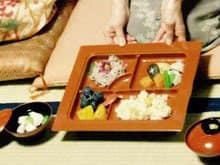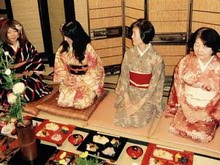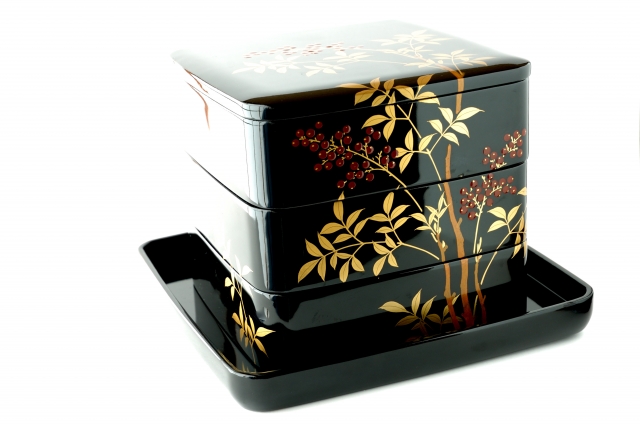
1.What’s ”JAPAN”:漆塗【URUSHI NURI】/漆器【SHIKKI】?
2.黒【KURO】/朱【SHU/AKA】/溜【TAME】…Traditional Colors of 漆器.
3.What’s 沈金【CHINKIN】,蒔絵【MAKIE】and 螺鈿【RADEN】?
4.Technique of 金継ぎ【KIN-TSUGI】which make chipped bowls more valuable and beautiful.
5.Production areas :輪島【WAJIMA】/中山【NAKAYAMA】/会津【AIZU】/新潟【NIIGATA】
1.What’s 漆器【SHIKKI】?The most JAPANtic craft having deep and beautiful shines.


漆器【SHIKKI】/漆塗【URUSHI-NURI】tablewares, furniture, arts, crafts are coated by sap of plant called 漆【URUSHI】. Sometimes In traditional architect, walls, floors, and pillows are painted with URUSHI.
It protect woods, papers and remains them more then few thousands years with it’s beautiful shine.
漆【URUSHI】had been used since 縄文時代【JYOUMON-ERA ( 1.6 million -3000 years ago)】and the world oldest one made in 9,000 years ago was found in Japan.
漆器【SHIKKI】/漆塗【URUSHI-NURI】were exported to western countries in 14 ‐16 century.
At that time, table wares and manners of 漆器【SHIKKI】were developed in feudal samurai society of 室町【MUROMACHI(1336‐1573)】area.
2.黒【KURO】/朱【SHU/AKA】/溜【TAME】…About traditional colors of 漆器.
黒漆【KURO(black)-URUSHI】is mixed with black iron oxide and 赤漆【AKA(red)-URUSHI】is mixed with red iron oxide called “Bengala”.


It is said that red ones are for males and black ones are for females, but recently that rule is not emphasized.

溜塗【TAME-NURI】is mysterious and noble dark brown 漆器【SHIKKI】 looks like 溜り醤油【TAMARI-SYOUYU(Thick Soy Sause)】.
It is a color of Red URUSHI added transparent black URUSHI later.
How to use お膳【OZEN】?
お膳【OZEN(Tray with lags)】is the most formal traditional Japanese meal style which is completed in middle aged feudal society.
一の膳【ICHI NO ZEN( The First tray)】:ご飯【GOHAN(Rice)】・味噌汁【MISO-SHIRU(Miso-soup)】・煮物【NIMONO(Boiled dish)】・なます【NAMASU(Vinegered fishes or vegetables )】・香の物【KOUNOMONO(Picklse)】
二の膳【NI NO ZEN( The Second tray)】・焼き物【YAKIMONO(Grilled dish)】
三の膳【SAN NO ZEN( The Third tray)】甘味【KANMI(Dessert)】・Fruits<For suvenior>
四の膳【YON NO ZEN( The Forth tray)】鯛の尾頭付【TAI NO O KASHIRA TSUKI(Grilled TAI fish with his head and tail)】<For suvenior>
Recently, 一汁三菜【ICHI JYUU SAN SAI(One Soup and Three Dishes)】style remains as Japanese dairy meals.
Nowadays, though various kinds of pottary or celemaics plates are used, a bowl of 味噌汁【MISO-SHIRU(Miso-Soup)】is 漆器【SHIKKI】.
※(Plastic bowls looks like Shikki are used recently, too, but it is interesting they prefer wooden-Shikki looks style bowls still now.)
3.What’s techniques are 沈金【CHINKIN】,蒔絵【MAKIE】and 螺鈿【RADEN】?
沈金【CHIN-KIN】is a technique to put gold into curved lines.
蒔絵【MAKIE】is a technique that patterns written by URUSHI are covered by gold or silver powders.

螺鈿【RADEN】is 漆器【SHIKKI】 decorated by mother-of pearl (shells). It had been imported from Middle East country in 6 century, and some of great works like 琵琶【BIWA(musical instrument like a guitar)】had been kept in 法隆寺【HOURYUUJI‐TEMPLE】in the very early days of Japanese history.
▶

4.Technique of 金継ぎ【KIN-TSUGI】which make chipped bowls more valuable.
When very important tableware like 抹茶茶碗【MATCHA CYAWAN】is lacked, some people do
金継ぎ【KIN-TSUGI】teqnique to repair it with 漆【URUSHI】 and gold. It does not only repair it, but also add more beauty and value as a tool. It is a traditional wisdom of taking good care of things and cherish it.
5.Production areas :輪島【WAJIMA】/中山【NAKAYAMA】/会津【AIZU】/新潟【NIIGATA】
輪島塗【WAJIMA-NURI】
会津塗【AIZU-NURI】
輪島塗【WAJIMA-NURI】
越前塗【ECHIZEN-NURI】
中山塗【NAKAYAMA-NURI】
鎌倉彫【KAMAKURA-BORI】
村上堆朱【MURAKAMI-TUISYU】
新潟塗【NIIGATA-NURI】
夕日塗【YUUHI-NURI】/花塗【HANA-NURI】/磯目塗【ISOME-NURI】/竹塗【TAKE-NURI】
▶The famous tea master 千利休【SEN NO RIKYUU】has created 黒楽茶碗【KURO-RAKU-CHAWAN】・赤楽茶碗【AKA-RAKU-CHAWAN】lools like 黒漆【KURO-URUSHI】・赤漆【AKA-URUSHI】 as Japan pride.

Leave a Reply